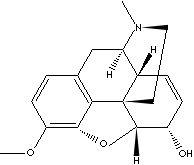| CAS
NO. |
76-57-3
(Base)
1422-07-7 (Hydrochloride) |

|
| EINECS
NO. |
|
| FORMULA |
C18H21NO3·H2O |
| MOL
WT. |
317.38 |
|
H.S.
CODE
|
|
|
SMILES |
|
|
TOXICITY
|
Oral rat LD50: 427 mg/kg |
| SYNONYMS |
Methyl morphine
monohydrate; |
| 7,8-Didehydro-4,5-alpha-epoxy-3-methoxy-17-methylmorphinan-
6-alpha-ol; 3-o-methylmorphine Monohydrate;
7,8-Didehydro-4,5-epoxy-3-methoxy- 17-methyl-(5alpha, 6alpha)-morphinan 6-ol;
Actacode; Calcidrine;
Codicept; Codalgin Forte Codate; (-)-Codeine; Codeinum; Coducept;
Metilmorfina; Morphine-3-methyl ether; Morphine monomethyl
ether; N-Methyl Norcodine; |
|
CLASSIFICATION
|
|
|
PHYSICAL
AND CHEMICAL PROPERTIES
|
| PHYSICAL
STATE |
white crystalline powder |
| MELTING
POINT |
154 - 156 C |
| BOILING
POINT |
250
C |
| SPECIFIC
GRAVITY |
1.32 |
| SOLUBILITY
IN WATER |
|
| pH |
|
| VAPOR
DENSITY |
|
| AUTOIGNITION |
|
| NFPA
RATINGS |
Health: 3 Flammability: 1 Reactivity: 1 |
|
REFRACTIVE
INDEX
|
|
| FLASH
POINT |
75
C
|
| STABILITY |
Stable
under ordinary conditions |
|
GENERAL
DESCRIPTION & APPLICATIONS
|
| Codeine is an alkaloid found naturally in opium in concentrations ranging from
0.7 to 2.5 percent. It is commercially synthesized from morphine. It is the most
widely used drug among the morphine class of compounds used in a variety of
pharmaceuticals including analgesics, antiperistaltics, antitussive agents,
hypnotics, and sedatives. Codeine is an opioid analgesic related to morphine but with less potential analgesic
property and mild sedative effect. Dihydrocodeine, called also drocode, is a similar opioid analgesic with
pharmaceutical action with codeine. It is known it has approximately twice
potentiality. It has also been used as an antitussive.
|
| SALES
SPECIFICATION |
|
APPEARANCE
|
white crystalline needles |
|
PURITY
|
99.0%
min (Dry Basis)
|
|
OPTICAL
ROTATION
|
-106°
~ -110° (C=1 in water)
|
|
WATER
|
10.0%
max
|
| TRANSPORTATION |
| PACKING |
|
| HAZARD
CLASS |
|
| UN
NO. |
|
| OTHER
INFORMATION |
| Hazard Symbols: , Risk Phrases: 20/21/22, Safety
Phrases: 26-36 |
